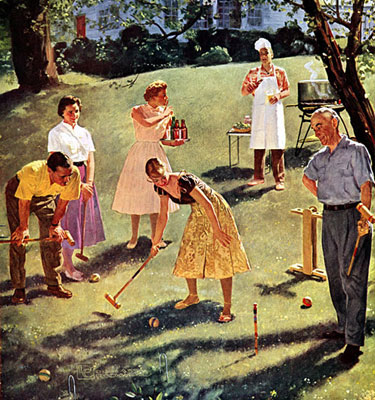 Spending countless hours trapped in a cold, dimly lit basement -- that's what I remember about Christmas.
Spending countless hours trapped in a cold, dimly lit basement -- that's what I remember about Christmas.
In fact, it's my favorite memory of Christmas. I don't remember gifts I gave or received (except for my pink Huffy bike in 1979), but I do remember making Christmas cookies with my mom, which we did together for 20 years. Each year, it was a massive project that began in the market, moved to the kitchen, and was completed in the basement.
After numerous trips to the grocery store to buy obscene amounts of flour, sugar, butter, eggs, and chocolate, we would bake for 4-5 days straight, making about 2,000 cookies (that is not hyperbole).
Everyone got a tray of our cookies, including the paper boy. It got to the point that people would make special requests of my mom: please put more biscotti or pignoli cookies on their tray.
My mom never complained; she had the patience of a saint. Even when I added baking soda instead of baking powder (which I did) or dropped eggs down the front of the refrigerator (did that too), she never yelled. She always said something like, "That's alright, honey. It can be cleaned up." Then we would start the recipe over again.

 Every Christmas morning, my sisters and I tumble downstairs, pause
to survey the adorned Douglas Fir and its outlying territory, then
continue to the kitchen. It’s a family tradition that before
fingertips ever meet wrapping paper, we sit down to a big breakfast of
bagels and lox and scrambled eggs with onions. In my less ripe years,
I considered this practice illogical frivolous excruciating;
however—predictably—as the son of God’s
Every Christmas morning, my sisters and I tumble downstairs, pause
to survey the adorned Douglas Fir and its outlying territory, then
continue to the kitchen. It’s a family tradition that before
fingertips ever meet wrapping paper, we sit down to a big breakfast of
bagels and lox and scrambled eggs with onions. In my less ripe years,
I considered this practice illogical frivolous excruciating;
however—predictably—as the son of God’s I’m nervous. I’m not sleeping well. The greatest challenge of my life is one month away and I have yet to start planning it: Christmas dinner. Everything will be riding on it. Not just my self-respect; the respect of my gender – every man who has ever said to his stay at home wife, “Hey, I’d take your job in a minute.” Well, she gave it to me. It’s all mine. And now I’ve got to deliver. Put a stunning meal on the table this Christmas; one that lets my hard working, career-driven wife know she married the right …well …wife.
I’m nervous. I’m not sleeping well. The greatest challenge of my life is one month away and I have yet to start planning it: Christmas dinner. Everything will be riding on it. Not just my self-respect; the respect of my gender – every man who has ever said to his stay at home wife, “Hey, I’d take your job in a minute.” Well, she gave it to me. It’s all mine. And now I’ve got to deliver. Put a stunning meal on the table this Christmas; one that lets my hard working, career-driven wife know she married the right …well …wife.
